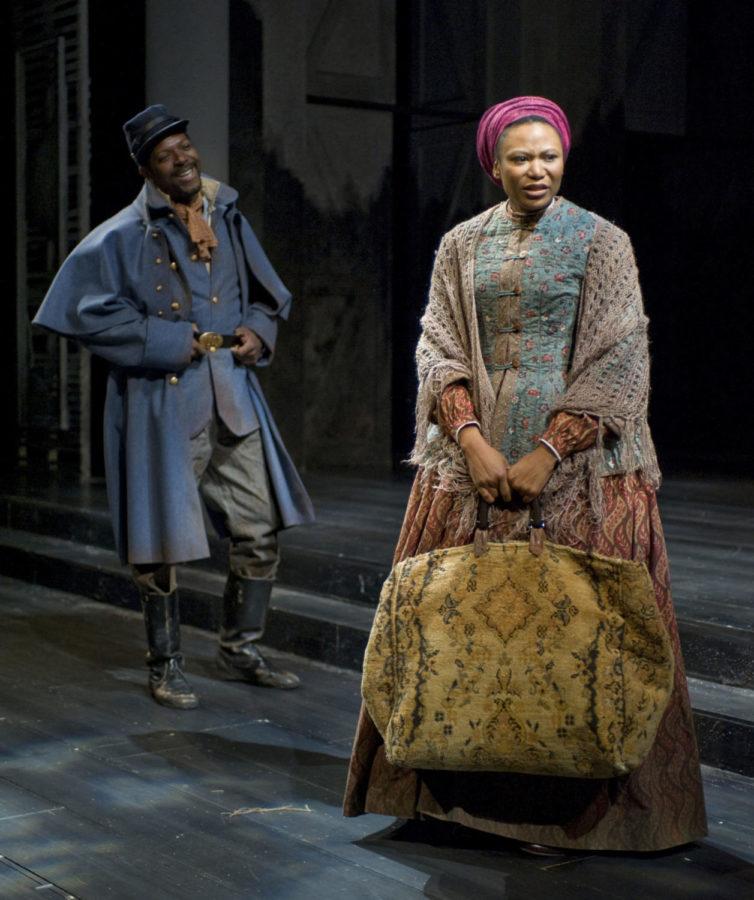Descending into the theater, I was immediately struck with an ominous feeling: Cloaked in black, the architecture was difficult to determine, except for a sliver of light emanating from the tip of the stage. As my eyes adjusted to the light, I began to make out the cloudy outline of fog lingering in a smoky haze all around the front of the theater. Though The March had yet to begin, it felt as if I had stumbled upon the ruins of some age-old battle scene, whose faint remnants were waiting patiently to reveal a story to me.
The play, directed by Frank Galati, is an adaption of the 2005 novel The March written by E.L. Doctorow, which takes as its subject a highly specific, isolated period of Civil War history. As tides began to turn in favor of the Union in 1864, General William Tecumseh Sherman of the North led a march of what eventually culminated in over 60,000 troops from Atlanta to the Carolinas. His troops, which moved through Savannah, then up the coast consisted mainly of refugees and freed slaves, and are compared in the text to a continuously growing organism that absorbed all that lay in its path. Sherman’s march burned cities, ravaged people and their property, pitted man against man, and blurred the division of North and South as soldiers often switched sides in hopes of making it through alive.
As with any novel’s theatrical adaptation, there are certain unavoidable restrictions. Telling the story of 60,000 soldiers with 26 characters was perhaps the biggest obstacle; to combat this, the play abandons the obsessive historicism of the text in favor of crafting an overarching sense of displacement that soon comes to define the piece as a whole.
Additionally, “timeless” scenes of the text must be limited to a very specific, very real period of time in the play. At just under three hours in length, the play succeeds in hanging on to the transcendental experience of reading a novel by including both quick, jolting, action-packed scenes and dreamy, drawn-out episodes, rife with hypnotic flashes of color and the gentle, fluid movements of its actors, not unlike the bodily flourishes one expects of a ballet dancer.
The flow of the play was further punctuated by a handful of monologues, given by soldiers and slaves alike, and the occasional onstage blackout to allow for short musical performances. Different characters took turns divulging to the crowd their hopes, plans, and opinions while looking directly out at the audience. General William Tecumseh Sherman (Harry Groener) spoke defiantly of his army’s explosive power, while escaped convict Will Kirkland (Stephen Louis Grush) complained of his fellow convict Arly Wilcox’s (Ian Barford) domineering ways, the two disguised as Union soldiers to evade imprisonment. Pearl, a freed slave of mixed race, bemoans her light skin as a betrayal of her black family, while the aristocratic fair lady Letita Pettibone (Martha Lavey) mourns the death of her late father and the impossibility of providing an appropriate burial ceremony with the high death toll of the war. By allowing many characters from such varying origins to intimately detail their own stories directly to the audience, Galati’s play underscores the ubiquitous effects of war on every gradation of American society.
The rustic wailings of a harmonica echoed out from the front of a dimmed stage while the back half was softly illuminated to reveal the quiet, sweeping motion of troops moving through dense foliage in the background. Sometimes, after an especially potent scene, the musical performances serve as a scene in and of themselves: a brief halt of action that encourages an artistic contemplation of the events preceding it. Through a literary lens, these gradations are analogous to a brief glance up from the text after making it through a particularly intense passage. In many ways, the play is mindful of its own transition from literature to drama, and makes efforts to ease this change.
At its most basic level, the play is about the trials and tribulations of the Civil War. But sitting in the audience, bearing witness to violent sieges, harrowing deaths, the destruction of cities, the disturbance of families, the cruelty of prejudice, and the dissolution of personal identity, it is impossible to brand The March as merely a dramatization of the Civil War. More so, it is a production interested in the psychology of war in general and the duration of its impact, though one cannot necessarily say that it ever really ends.
The play concludes with Pearl and her lover Sergeant Stephen Walsh, an opportunistic Irish soldier, chatting excitedly about their imagined future together in New York. But as the lights dim on the hopeful couple and the fog crowds in overhead once more, the viewer is left with the grim sensation of the infectious and inescapable nature of warfare.








